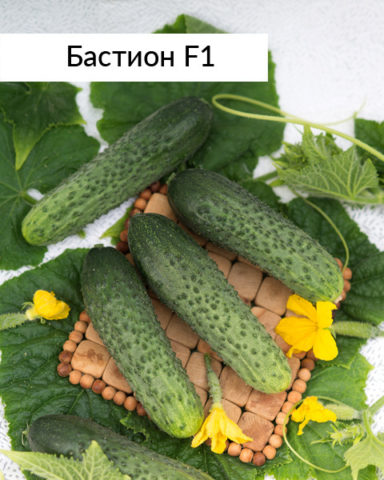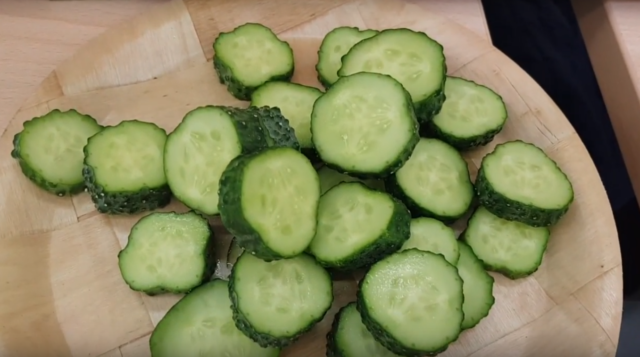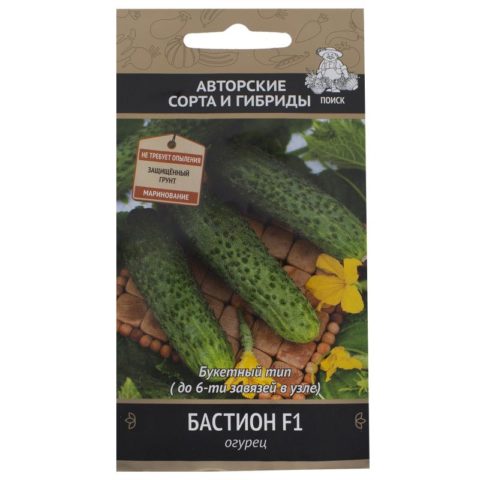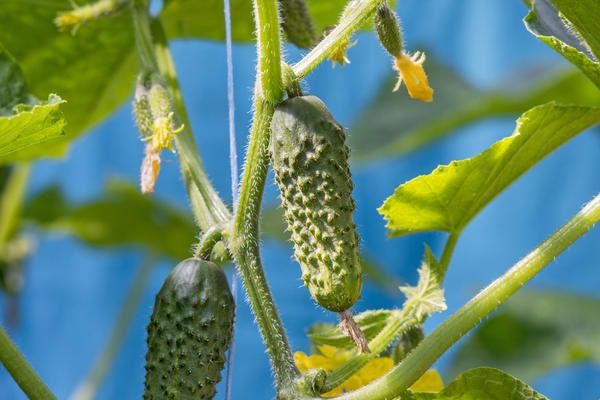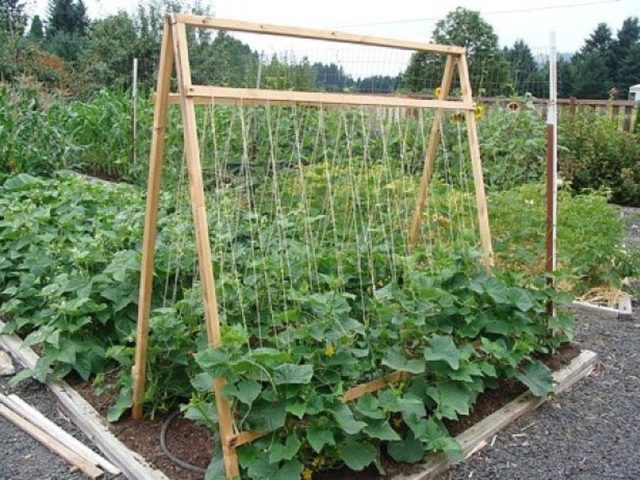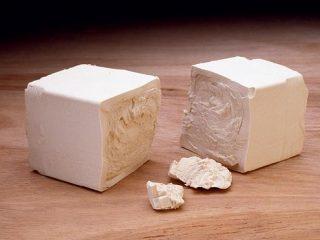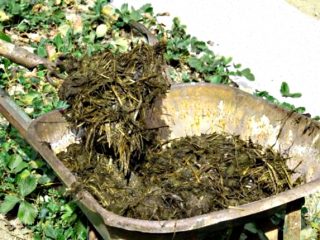Content
The Bastion cucumber is an unpretentious parthenocarpic in terms of growing conditions; it attracts with its precocity and resistance to diseases characteristic of the crop. The taste of the culture is traditional, its purpose is universal.
History of variety selection
Hybrid Bastion is recognized as an interesting new product for 2015. Cucumber from the series “Author’s varieties and hybrids” from Agrofirm “Poisk”. This is a group of varieties of different crops - the result of the work of breeders for more than 20 years. Vegetable growers adhere to the main direction in selecting plants - preserving traditional high taste qualities, as in the work on the Bastion f1 cucumber.
Description of the cucumber variety Bastion
By sowing parthenocarpic Bastion cucumbers, you can be sure of a good harvest. The variety has a well-developed root system, regardless of the type of soil, spreads widely in search of nutrients and provides them with vigorous growing vines. Cucumber Bastion is of an indeterminate type and requires mandatory formation. After pinching, the announced number of greens is collected. Cucumber stems are powerful and have medium branching. The foliage is normal.Flowers of the female type, with an ovary.
Description of fruits
The medium-sized fruits of the Bastion f1 cucumber are pimply, with large and frequent tubercles, randomly located along protruding stripes on the dark green skin. The pimples visually end with thorns characteristic of cucumbers; in this variety they are white. The length of the fruit at technical ripeness is 12-15 cm. The diameter of the fruit is from 3.5 to 4.5 cm. The average weight of harvested cucumbers is from 130 to 160 g.
There are no internal cavities. The pulp of the Bastion variety is elastic, juicy, and habitually crunchy when eaten. Cucumbers retain their natural color and do not turn yellow. The taste is pleasant, the skin and pulp are not bitter. Bastion cucumbers can be harvested in the gherkin stage, when they weigh 90-95 g.
Characteristics of the variety
Hybrid Bastion is hardy thanks to powerful roots that adapt well to various types of soil.
Productivity and fruiting
The success of the Bastion variety lies in its early ripening. Cucumbers are ready for harvesting already on the 40-45th day of bush development. If the seeds are planted directly into the soil, wait until it warms up to 15 °C. In different regions this is the end of April or May. The Bastion cucumber harvest will ripen in less than 1.5 months after germination, by the end of June or mid-July. In a heated greenhouse, sowing dates are regulated by gardeners.
The cucumber variety Bastion has ovaries bouquet type, up to 6 fruits are created in a node. From a bush they collect from 5 kg. Productivity increases when all agricultural technology requirements are met, including proper cane formation, regular watering and fertilizing. Greater harvest of cucumbers in the greenhouse, since the room maintains comfortable temperature conditions for the plant.The ovaries grow larger if the greens are regularly collected: gherkins every other day, and larger fruits for pickling - after 2-3 days. Severing the fruit stimulates the plant to form new cucumbers. It is always noted that the hybrid bears fruit even in conditions of temperature changes and tolerates cool weather well.
Application area
Elastic, tasty Bastion f1 cucumbers, judging by reviews, are used with pleasure for fresh salads. They are salted, pickled, canned. Dense, void-free pieces of cucumber are cut for quick freezing.
Resistance to diseases and pests
Hybrid Bastion is higher in yield because it is immune to the common fungal disease cladosporiosis or brown (olive) spot. It is also not affected by the cucumber mosaic virus. The Bastion variety is moderately resistant to powdery mildew pathogens. In greenhouses, if not properly cared for, cucumbers can be attacked by aphids or whiteflies. First, they try folk remedies or use insecticides.
Advantages and disadvantages of the variety
In reviews of Bastion cucumbers, summer residents name the distinctive features of the variety:
- early ripeness;
- friendly return of the harvest;
- endurance to weather stress conditions: drought and cold resistance;
- high commercial properties;
- versatility in growing and using fruits.
Many people believe that the disadvantage of Bastion cucumbers is that the hybrid produces a low yield, less than 10 kg per 1 square meter. m.
Rules for planting and care
Unpretentious to weather conditions, the hardy variety Bastion is planted directly into holes in the garden. If you want to grow an early harvest of cucumbers, 2-3 weeks faster, use the seedling method.
Planting seedlings
Cucumber seedlings develop quickly.3 weeks after germination, the seedlings are already moved to the site. For a vegetable garden or film shelter without heating, cucumber seeds are planted in mid-April. The grains are processed and packaged at the originator’s company’s enterprises: for Bastion hybrid seeds, gardeners do not carry out pre-sowing preparation. In the fall, they stock up on substrate if they do not purchase ready-made soil for seedlings. Take equal parts of garden soil and humus, add peat and sand to make the substrate loose. For nutritional value, the soil in the container is spilled with a ready-made preparation for fertilizing “Universal” or “Kemira”.
Growing seedlings:
- The seeds are deepened by 1.5-2 cm, sprinkled with soil, covered with film and placed in a warm place above 23 °C.
- After 5-6 days, shoots appear.
- For several days the temperature is reduced to 19 °C, at night not lower than 16 °C.
- Stronger sprouts are provided with a comfortable environment: light and temperature 23-25 °C.
- Water after 1-2 days so that the substrate does not dry out.
- After the appearance of the 3rd leaf, Bastion cucumbers are fertilized with nitrophoska: a teaspoon of the product is diluted in a liter of warm water.
- The seedlings are moved to a permanent place at the age of 21-27 days.
Growing cucumbers using the seedless method
At an air temperature of 20-21 °C, the seeds of the parthenocarpic cucumber variety Bastion are planted in holes to a depth of 3 cm according to a 90x35 cm pattern. For optimal yield, vertical or inclined trellises are erected, sometimes from poles.
Aftercare
Water the cucumbers daily or every other day, guided by precipitation. It is better to irrigate the area in the evening using a watering can, so that warm water moisturizes the root system, but does not fall on the lower part of the central stem.Leaves are also protected from splashes. In the morning the earth is loosened and cleaned weeds.
At the fruiting stage, the Bastion hybrid is fertilized after 10-12 days, alternating mineral preparations and organic matter:
- mullein;
- bird droppings;
- herbal infusion.
The fungicide “Previkur”, which is used to treat seedlings, helps protect cucumbers from diseases.
Bush formation
Parthenocarpic cucumbers impress with their yield when properly formed. If you leave all the ovaries and shoots, even the powerful root system of the hybrid will not be able to “feed” the plant.
One method suggests:
- From the first 3-4 lower nodes, completely remove the ovaries and shoot buds.
- Fruits are created on the following nodes of the central stem, from which the lateral stepsons are first also removed.
- After collecting the fruits from the central stem, the bush is fed.
- The side shoots grow again and form a second wave of the harvest.
Conclusion
The Bastion cucumber will give a good harvest if you pay enough attention to the plant. Regular watering with warm water, fertilizing, and the formation of vines will reward you with tasty and aromatic vegetables.
